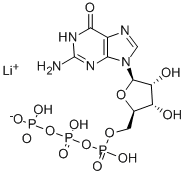GTP LITHIUM SALT
Synonym(s):GTP lithium salt
- CAS NO.:85737-04-8
- Empirical Formula: C10H15LiN5O14P3
- Molecular Weight: 529.11
- MDL number: MFCD00070012
- EINECS: 288-514-3
- SAFETY DATA SHEET (SDS)
- Update Date: 2023-04-23 13:52:06

What is GTP LITHIUM SALT?
The Uses of GTP LITHIUM SALT
Guanosine 5′-triphosphate lithium salt has been used:
- In ribosome activity assay.
- In tubulin isolation and polymerization.
- In the determination of cell viability.
What are the applications of Application
Guanosine 5′-triphosphate dilithium salt is a stable 5′-GTP preparation
What are the applications of Application
Guanosine 5′-triphosphate lithium salt is a carrier of phosphates and pyrophosphates
Biochem/physiol Actions
GTP functions as a carrier of phosphates and pyrophosphates involved in channeling chemical energy into specific biosynthetic pathways. GTP activates the signal transducing G proteins which are involved in various cellular processes including proliferation, differentiation, and activation of several intracellular kinase cascades. Proliferation and apoptosis are regulated in part by the hydrolysis of GTP by small GTPases Ras and Rho. Another type of small GTPase, Rab, plays a role in the docking and fusion of vesicles and may also be involved in vesicle formation. In addition to its role in signal transduction, GTP also serves as an energy-rich precursor of mononucleotide units in the enzymatic biosynthesis of DNA and RNA.
Properties of GTP LITHIUM SALT
| storage temp. | -20°C |
| solubility | H2O: 100 mg/mL |
| form | powder |
| color | white |
Safety information for GTP LITHIUM SALT
| Signal word | Warning |
| Pictogram(s) |
 Exclamation Mark Irritant GHS07 |
| GHS Hazard Statements |
H315:Skin corrosion/irritation H319:Serious eye damage/eye irritation H335:Specific target organ toxicity, single exposure;Respiratory tract irritation |
| Precautionary Statement Codes |
P261:Avoid breathing dust/fume/gas/mist/vapours/spray. P264:Wash hands thoroughly after handling. P264:Wash skin thouroughly after handling. P271:Use only outdoors or in a well-ventilated area. P280:Wear protective gloves/protective clothing/eye protection/face protection. P302+P352:IF ON SKIN: wash with plenty of soap and water. P305+P351+P338:IF IN EYES: Rinse cautiously with water for several minutes. Remove contact lenses, if present and easy to do. Continuerinsing. |
Computed Descriptors for GTP LITHIUM SALT
New Products
(S)-3-Aminobutanenitrile hydrochloride 4-Methylphenylacetic acid N-Boc-D-alaninol N-BOC-D/L-ALANINOL Tert-butyl bis(2-chloroethyl)carbamate 3-Morpholino-1-(4-nitrophenyl)-5,6-dihydropyridin- 2(1H)-one Furan-2,5-Dicarboxylic Acid Tropic acid 1-Bromo-3,5-Di-Tert-Butylbenzene S-2-CHLORO PROPIONIC ACID ETHYL ISOCYANOACETATE 2-Bromo-1,3-Bis(Dimethylamino)Trimethinium Hexafluorophosphate 4-IODO BENZOIC ACID 3-NITRO-2-METHYL ANILINE 1-(2,4-DICHLOROPHENYL) ETHANAMINE (2-Hydroxyphenyl)acetonitrile 4-Bromopyrazole 2-(Cyanocyclohexyl)acetic acid 4-methoxy-3,5-dinitropyridine 1-(4-(aminomethyl)benzyl)urea hydrochloride 2-aminopropyl benzoate hydrochloride diethyl 2-(2-((tertbutoxycarbonyl)amino) ethyl)malonate tert-butyl 4- (ureidomethyl)benzylcarbamate Ethyl-2-chloro((4-methoxyphenyl)hydrazono)acetateRelated products of tetrahydrofuran








You may like
-
 Guanosine 5′-triphosphate lithium salt CAS 85737-04-8View Details
Guanosine 5′-triphosphate lithium salt CAS 85737-04-8View Details
85737-04-8 -
 2033-24-1 98%View Details
2033-24-1 98%View Details
2033-24-1 -
 1975-50-4 98%View Details
1975-50-4 98%View Details
1975-50-4 -
 2-HYDROXY BENZYL ALCOHOL 98%View Details
2-HYDROXY BENZYL ALCOHOL 98%View Details
90-01-7 -
 2-Chloro-1,3-Bis(Dimethylamino)Trimethinium Hexafluorophosphate 221615-75-4 98%View Details
2-Chloro-1,3-Bis(Dimethylamino)Trimethinium Hexafluorophosphate 221615-75-4 98%View Details
221615-75-4 -
 61397-56-6 CIS BROMO BENZOATE 98%View Details
61397-56-6 CIS BROMO BENZOATE 98%View Details
61397-56-6 -
 14714-50-2 (2-Hydroxyphenyl)acetonitrile 98+View Details
14714-50-2 (2-Hydroxyphenyl)acetonitrile 98+View Details
14714-50-2 -
 118753-70-1 98+View Details
118753-70-1 98+View Details
118753-70-1